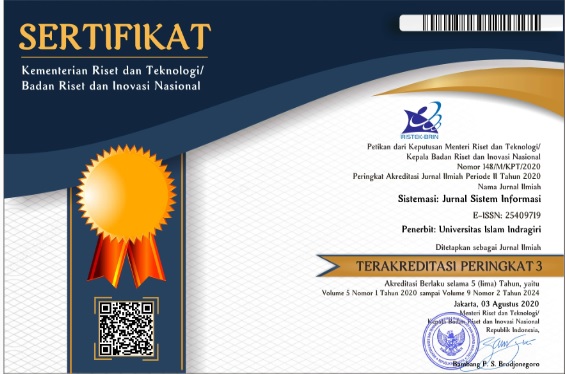Sentiment Analysis of Rohingya Refugees in Aceh using Support Vector Machine (SVM) and Multinomial Logistic Regression
Abstract
Keywords
Full Text:
PDFReferences
O. Manullang, C. Prianto, and N. E. Harani, “Analisis Sentimen untuk memprediksi Hasil Calon Pemilu Presiden menggunakan Lexicon based dan Random Forest,” J. Ilm. …, no. 54, pp. 1–11, 2023, [Online]. Available: https://forum.upbatam.ac.id/index.php/jif/article/view/7987%0Ahttps://forum.upbatam.ac.id/index.php/jif/article/download/7987/3319
A. N. Ramadhan, E. Utami, and A. D. Hartanto, “Analisis Sentimen Opini Publik menggunakan Metode BiLSTM pada Media Sosial Twitter,” Semiot. (Seminar Nas. Teknol. Inf. dan Mat., vol. 2, no. 1, pp. 1–12, 2023.
Y. Azhari and Wilopo, “Pencegahan Potensi Konflik antara Pengungsi Rohingya dan Masyarakat Lokal Indonesia,” JPM (Jurnal Pengabdi. Mandiri, vol. 1, no. 3, pp. 475–488, 2022.
U. Kurniasih and A. T. Suseno, “Analisis Sentimen Masyarakat terhadap Isu Migrasi Rohingya ke Indonesia,” J. Teknol. Dan Sist. Inf. Bisnis, vol. 7, no. 1, pp. 199–207, 2025, doi: https://doi.org/10.47233/jteksis.v7i1.1815.
A. R. Usman, A. Sulaiman, M. Muslim, and T. Zulyadi, “Conflict and Cultural Adaptation of the Aceh Rohingya Refugees in Media Opinion,” Profetik J. Komun., vol. 16, no. 1, pp. 107–122, 2023, doi: 10.14421/pjk.v16i1.2491.
D. Ananda and R. R. Suryono, “Analisis Sentimen Publik terhadap Pengungsi Rohingya di Indonesia dengan Metode Support Vector Machine dan Naïve Bayes,” J. Media Inform. Budidarma, vol. 8, no. 2, pp. 748–757, 2024, doi: 10.30865/mib.v8i2.7517.
H. Hidayat, F. Santoso, and L. F. Lidimillah, “Analisis Sentimen Pengguna YouTube tentang Rohingya menggunakan Algoritma SVM (Support Vector Machine),” G-Tech J. Teknol. Terap., vol. 8, no. 3, pp. 1729–1738, 2024, doi: 10.33379/gtech.v8i3.4497.
A. Novantika and Sugiman, “Analisis Sentimen Ulasan Pengguna Aplikasi Video Conference Google Meet menggunakan Metode SVM dan Logistic Regression,” Prism. Pros. Semin. Nas. Mat., vol. 5, pp. 808–813, 2022, [Online]. Available: https://journal.unnes.ac.id/sju/index.php/prisma/
N. K. Putri, A. V. Vitianingsih, S. Kacung, A. L. Maukar, and V. Yasin, “Sentiment Analysis of Brand Ambassador Influence on Product Buyer Interest using KNN and SVM,” Indones. J. Artif. Intell. Data Min., vol. 7, no. 2, pp. 327–336, 2024, doi: 10.24014/ijaidm.v7i2.29469.
T. S. Sabrila, Y. Azhar, and C. S. K. Aditya, “Analisis Sentimen Tweet tentang UU Cipta Kerja menggunakan Algoritma SVM berbasis PSO,” JISKA (Jurnal Inform. Sunan Kalijaga), vol. 7, no. 1, pp. 10–19, 2022, doi: 10.14421/jiska.2022.7.1.10-19.
K. H. Yunior, A. V. Vitianingsih, S. Kacung, A. Lidya Maukar, and A. Dwi Arumsari, “Sentiment Analysis of Cyberbullying Detection on Social Networks using the Sentistrenght Method,” Sistemasi, vol. 13, no. 4, pp. 1587–1596, 2024, doi: 10.32520/stmsi.v13i4.4226.
R. I. Putra Selian, A. V. Vitianingsih, S. Kacung, A. Lidya Maukar, and J. Febrian Rusdi, “Sentiment Analysis of Public Responses on Social Media to Satire Joke using Naive Bayes and KNN,” Sinkron, vol. 8, no. 3, pp. 1443–1451, 2024, doi: 10.33395/sinkron.v8i3.13721.
P. Sayarizki, Hasmawati, and H. Nurrahmi, “Implementation of IndoBERT for Sentiment Analysis of Indonesian Presidential Candidates,” Indones. J. Comput., vol. 9, no. 2, pp. 61–72, 2024, doi: 10.34818/indojc.2024.9.2.934.
Y. Nurdiansyah, F. Rahman, P. Pandunata, and A. Infantono, “Analisis Sentimen Opini Publik terhadap Undang-Undang Cipta Kerja pada Twitter menggunakan Metode Naive Bayes Classifier,” Pros. Semin. Nas. Sains Teknol. dan Inov. Indones., vol. 3, no. November, pp. 201–212, 2021, doi: 10.54706/senastindo.v3.2021.158.
F. Rizal, A. Wijaya, and F. Hasyim, “Analisis Sentimen Masyarakat Indonesia terhadap Aplikasi TikTok menggunakan Algoritma Logistic Regression,” AKIRATECH J. Comput. Electr. Eng., vol. 1, no. 2, pp. 57–65, 2024, [Online]. Available: https://journal.ajbnews.com/index.php/akiratech
M. P. Pulungan, A. Purnomo, and A. Kurniasih, “Penerapan SMOTE untuk mengatasi Imbalance Class dalam Klasifikasi Kepribadian MBTI menggunakan Naive Bayes Classifier,” J. Teknol. Inf. dan Ilmu Komput., vol. 11, no. 5, p. 1033=1042, 2024, doi: 10.25126/jtiik.1077989.
N. S. Ramadan and D. Darwis, “Perbandingan Metode Naïve Bayes dan SVM untuk Sentimen Analisis Masyarakat terhadap Serangan Ransomware pada Data KIP-K,” J. Sist. Inf. dan Inform., vol. 8, no. 1, pp. 12–23, 2025, doi: https://doi.org/10.47080/simika.v8i1.3621.
R. Fajriah and D. Kurniawan, “Optimalisasi Model Klasifikasi Naive Bayes dan Support Vector Machine dengan Fast Text dan Chi Square,” Fakt. Exacta, vol. 17, no. 4, pp. 334–345, 2025, doi: 10.30998/faktorexacta.v17i4.24751.
S. Rabbani, D. Safitri, N. Rahmadhani, A. A. F. Sani, and M. K. Anam, “Perbandingan Evaluasi Kernel SVM untuk Klasifikasi Sentimen dalam Analisis Kenaikan Harga BBM,” MALCOM Indones. J. Mach. Learn. Comput. Sci., vol. 3, no. 2, pp. 153–160, 2023, doi: 10.57152/malcom.v3i2.897.
B. L. Fauzan, T. Agustin, and A. M. H. Mahmudah, “Prediksi Klasifikasi Kecelakaan Lalu Lintas di Kota Surakarta dengan menggunakan Metode Regresi Logistik Multinomial,” Sustain. Civ. Build. Manag. Eng. J., vol. 1, no. 4, pp. 1–9, 2024, doi: 10.47134/scbmej.v1i4.3159.
S. S. Dewi, R. Resmawan, and L. O. Nashar, “Analisis Regresi Logistik Multinomial dengan Metode Bayes untuk Identifikasi Faktor-Faktor terjadinya Diabetes Melitus,” J. Math. Theory Appl., vol. 5, no. 2, pp. 51–60, 2023, doi: 10.31605/jomta.v5i2.2520.
Z. M. E. Darmawan and A. F. Dianta, “Implementasi Optimasi Hyperparameter GridSearchCV pada Sistem Prediksi Serangan Jantung menggunakan SVM Implementation of GridSearchCV Hyperparameter Optimization in Heart Attack Prediction System using SVM,” Unipdu, vol. 13, no. 1, pp. 8–15, 2023, doi: https://doi.org/10.26594/teknologi.v13i1.3098.
E. Damayanti, A. V. Vitianingsih, S. Kacung, D. Cahyono, and A. L. Maukar, “Sentiment Analysis of Alfagift Application User Reviews using Long Short-Term Memory (LSTM) and Support Vector Machine (SVM) Methods,” Decod. J. Pendidik. Teknol. Inf., vol. 4, no. 2, pp. 509–521, 2024, doi: 10.51454/decode.v4i2.478.
B. Ayuningrum, H. H. M. Haqq, S. M. P. Lestari, and M. Al Haris, “Analisis Sentimen Survei Regsosek pada Twitter menggunakan Algoritma K-Nearest Neighbor (K-NN),” ESTIMASI J. Stat. Its Appl., vol. 4, no. 2, pp. 196–207, 2023, doi: https://doi.org/10.20956/ejsa.v4i2.25522.
DOI: https://doi.org/10.32520/stmsi.v14i3.5159
Article Metrics
Abstract view : 496 timesPDF - 152 times
Refbacks
- There are currently no refbacks.

This work is licensed under a Creative Commons Attribution-ShareAlike 4.0 International License.









